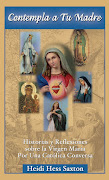
As we wind our way toward Lent, I wanted to share with you a story that made me think of the first time I watched The Passion of the Christ and saw the intimate connection between Mary and her Son. As she followed Him as He took His final steps along the Via Dolorosa. Tensing, then melting as she sensed His presence, chained in the hell hole beneath her feet. Watching with eyes full of soundless anguish as she stood helpless, watching her baby boy's back flayed open by the Roman guard.
It is unthinkable. Unimaginable. Horrific. In some ways, the pain must have been even more unbearable for her than it was for Him, for nothing is worse than watching someone you love die a slow, torturous death. She bore it bravely, even silently (at least in the movie). Somehow she lived through that endless night, and opened her eyes again early that Sunday morning.
Though just how she did it, we'll never know.
I just finished reading Broken and Blessed, Cathy's tribute to her infant daughter Celeste, who at four months of age died of complications from a specific heart defect, and had the same reaction: Just how she did it, I have no idea.Cathy writes about her daughter:
The place where Celeste's suffering is acknowledged is a place I cannot visit too frequently; the pain it evokes is too raw. But to deny the existence of it, to not realize its value and even its beauty would be wrong.
She suffered. From the moment of her birth, she was denied the comfort of her mother's arms, and the joy of nursing. ... Some sufferings were more intense. She endured more IV procedures than I can remember, some involving the OR method known as a "cut-down." Her head was even partially shaved for some of these, while others were inserted into her hands, feet, and even her jugular vein.... There is nothing like seeing your baby's blood (81-82).
Even so, she managed to find the blessing in it. That is the miracle. That is the hope. "Our lives are precious gifts meant to be tended with care," Cathy writes. "The world I had once viewed in black and white began to take on brilliant shades of gray. I sought to see the gifts others had to bring, and I desired to know my own. .... There were no black armbands in the Adamkiewicz household. Instead, we mourned in Technicolor, figuratively and quite literally. ... The pendulum had swung to the farthest reaches of sadness, and now I was hastening it back to a place of joy and beauty" (p.169).
Cathy's message of hope in the midst of great suffering is an especially appropriate one for us to consider this time of year. As we contemplate the Passion and Death of Our Lord, we are reminded of the great joy that is heightened by this season of tremendous suffering. Without Good Friday there can be no Easter. Without the cross, no resurrection.
If you would like more information about Cathy's book, or would like to order a copy, click here.












 My StumbleUpon Page
My StumbleUpon Page